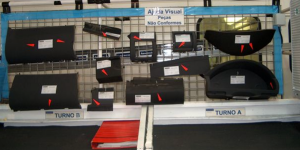 THE TOOLS CORNER – This month, the author discusses how we can ensure quality problems are identified early, tackled swiftly and prevented from reoccurring.
THE TOOLS CORNER – This month, the author discusses how we can ensure quality problems are identified early, tackled swiftly and prevented from reoccurring.
Words: Michael Ballé, lean author, executive coach and co-founder of Institut Lean France
WHAT ARE THEY?
Quality judgment criteria allow for a clear quality decision over a completed job element.
Boundary conditions are found on work samples where one can visually see the difference between OK and not-OK.
WHY ARE THEY SO CLEVER?
The first rule of Kanban is to never send defectives to the subsequent process.
Actually, the real secret of Toyota’s success is its deep, deep awareness that quality is its lifeline. Since the days of its founders, the company has seen maintaining and enhancing quality as its most important responsibility to its customers, and the basis of its social responsibilities.
The company works hard at both “building quality into the original stages of design and production engineering” and “building quality into processes at individual manufacturing stages”.
What does building quality into something mean? That each step is responsible for its own quality and commits to not accept, make and pass on a defect, agreeing to stop and call for help.
Easier said than done. The first difficulty with this is recognizing a defect. I am not talking about the blatant, obvious defects that would be spotted at quality control, but the more subtle, enmeshed defects that take value out of the product once it’s in the hands of the customer.
Clear-cut defects are rarely a problem because quality inspections can usually catch them and isolate them. But customer complaints are often caused by a chain of more subtle defects that haven’t been spotted in the process, accumulate unhappily, and align to create a failure.
HOW DOES IT WORK?
The first step towards quality is therefore to ensure that any person in charge of any process is able to distinguish a defect in ambiguous conditions.
The lean tool for this is boundary samples, which show on the same piece of work the OK part and the Not-OK part so that the person can get a feel for what’s good and what’s not.
The second step of quality is making each person feel responsible for their own quality by explaining the impact of these borderline parts on the final quality of the product.
The third step is engaging every person in retaining their continued interest in and awareness of defectives, involving them in kaizen and developing high personal standards by continuously trying to improve quality and eliminate defectives.
The two questions we should always ask ourselves are:
- Is this a good result or a bad one (and how can we tell)?
- Did we achieve this by a repeatable process or by luck?
The key to asking yourself the second question meaningfully is to always challenge yourself on the first – whatever I do, how can I tell the difference between OK and Not-OK? In what context? And how deeply do I understand the impact of Not-OK on both proximal and final customers.
Looking at any piece of work we can ask ourselves what the criteria are for judging OK from Not-OK, and then break it down for each job element:
- Are these criteria concrete, measurable and do they allow for quick judgment?
- Does each criteria correlate with the overall objectives of the job?
- Can we break them down into “one element, one decision”?
- Can the judgment on the criteria clear with confidence the decision to get on with the next element of work?
How we document this in greater and greater detail as we go on is also critical.
SO WHAT?
Maintaining high standards in any job is hard as it becomes routine – there is no human way to avoid habituation and the temptation to do the job mindlessly. This must be accepted as a starting point. Consequently, it’s up to management to continuously sustain quality awareness through activities that aim to keep returning to the basics, distinguishing OK from Not-OK in various ambiguous conditions, solving problems in the process to make the unpredictable parts more predictable, and capturing and teaching this knowledge to others.
The real, enduring key to success is learning to identify quality problems early, take on-the-spot responsibility for fixing them and preventing their reoccurrence at any cost before they can inconvenience a customer or cause a complain. Quality awareness starts with understanding the boundary conditions and judgement criteria in any job, and any work element.
THE AUTHOR

Michael Ballé is co-founder of the Institut Lean France. An associate researcher at Telecom ParisTech, he holds a doctorate from the Sorbonne in Social Sciences and Knowledge Sciences. Michael is a best-selling author and an engaging speaker, and managing partner of ESG Consultants. He also works as a lean executive coach in various fields, from manufacturing to engineering, services to healthcare. His latest book, The Lean Strategy (co-authored with Dan Jones, Jacques Chaize and Orry Fiume) is available here.
